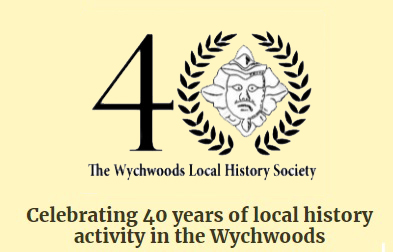
As we mark the closing of another year and look forward to the dawning of a new one, here is a short article befitting the marking of passing time. It was written by Sue Jourdan and is taken from the WLHS Journal No. 22 (2007). We republish it here as the last of our occasional series celebrating the work of the Society over the past 40 years. (A PDF of the article can be found here).
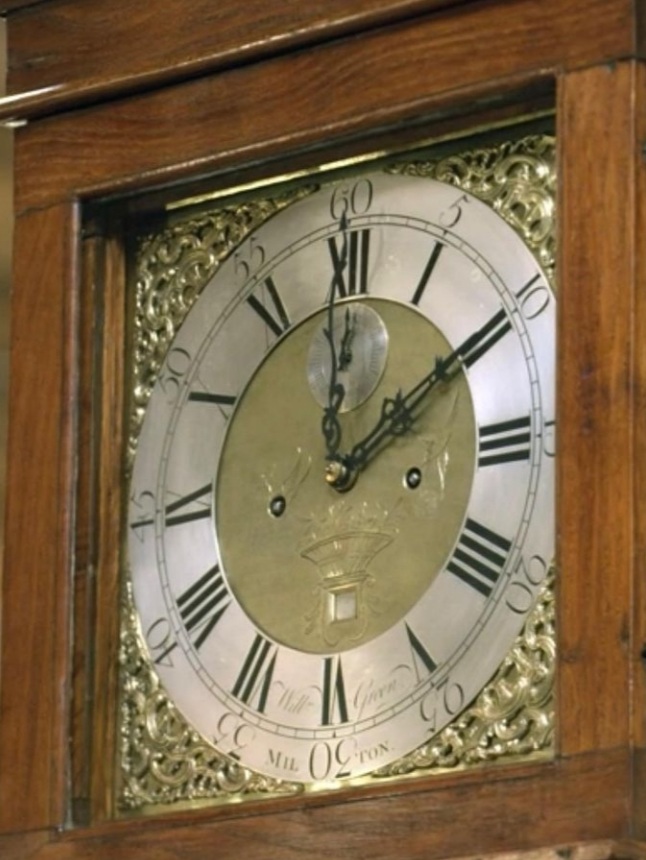
Post Script: Quite by chance, WLHS Secretary and researcher John Bennett noticed a clock by William Green of Milton featured on the BBC’s “Repair Shop”, broadcast on January 5th. Regrettably they did not mention anything about the maker, but the name is clearly visible on the clock face, and we see the clock’s inner workings. The programme is available on iPlayer here [ Series 8, Episode 11: link active January 8th 2022 ].
From WLHS Journal No 22
Peter Meecham, Clockmaker, who has lived in Milton under Wychwood all his life, now has in his collection five clocks made by William Green of Milton under Wychwood. William’s name is inscribed on the dial and from the style of the clocks it would appear that William was a Quaker. The first mention of a Quaker meeting in Milton under Wychwood was at Robert Secoll’s house in 1655 with a meeting house built by 1669. It would appear that these properties were in Green Lane as that is the site of the Quaker burial ground and there are still properties called Quaker’s Meet and Quaker’s Piece.
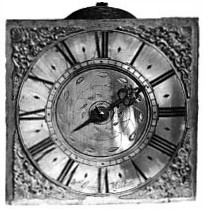
A: A typical 30 hour clock, that is, it has to be wound every day, made about 1760 with a brass dial engraved in the centre with a leaf pattern. Engraved Roman numerals on an applied chapter ring, cornucopia spandrels and steel single hand, coloured blue. This clock would have hung on the wall without a case.
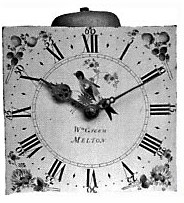
B: Similar 30-hour movement but with a painted dial, which would have been obtained from Birmingham, and two hands, made about 1775. Brass dials had become unfashionable by this time.
Because of their religious convictions, Quakers were unable to swear the Oath of Allegiance and therefore were excluded from higher education or from joining a guild in a town. Clock making was one area where they could apply their skills and, working in country districts, they produced simple inexpensive clocks in localised family networks whose primary bond was one of religious affiliation. How much local fabrication was done by apprentices and to what extent they assemble movements and fitted cases is not known but the Quakers worked to a basic similar design, possibly obtaining engraved dial plates, chapter rings and spandrel castings (corner castings) from someone like Gilkes of Adderbury (1715-1787) another Quaker clockmaker who supplied parts to others.
The Gilkes were a large family of clockmakers working in north Oxfordshire and south Warwickshire in the eighteenth century. Many were one-handed clocks as these were simpler and cheaper to make, and of the four examples illustrated two are single and two have two hands. Again with cost in mind they are 30 hour long case clocks with a frame to hang on the wall without a case with two metal spikes to push into the plaster wall. Any clock without a case is more vulnerable to damage.

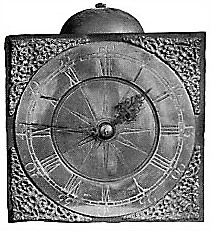
C and E: Another brass dialled movement, this time with two hands, of about 1760 and a different star engraving to the centre. The case is of cherry wood and was bought as an extra, most likely made by the village carpenter or undertaker.
The addition of the case would have doubled the purchase price but protected the movement from dust and the hanging weight and pendulum from children, pets and draughts, thus prolonging the time between costly overhauls and improving the accuracy of the time keeping. The clock case would have been made separately by the local carpenter, undertaker or joiner and were usually in inexpensive woods like in pine or oak. Customers would have been local farmers and shop keepers.

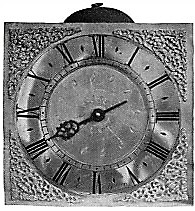
D and F: Another single-handed movement similar to A but with a different hand pattern and urn-style spandrels. This is in a pine case, originally painted and varnished.
It has not been possible to find out much about William Green but C.F.C Beeson in Clockmaking in Oxfordshire 1400-1850 suggests that he was born in 1722, possibly the son of Isaac and Joan Green of Tadmarton, and died in 1770. In John Kibble’s Historical and Other Notes on Wychwood Forest in 1928 he states ‘William Green of Milton under Wychwood had a clock club into which so much per week was paid to get a clock.
References
1 Clockmaking in Oxfordshire 1400-1850. CFC Beeson. Museum of Science 3rd ed 1989. pp 107
2 Historical and Other Notes on Wychwood Forest. John Kibble. 1928. pp 46
More about William Green: Milton’s Quaker Clockmaker
A 2014 article published in the Wychwood Magazine is taken from Tim Marhshall’s book “The Quaker Clockmakers of North Oxfordshire” >> PDF here

